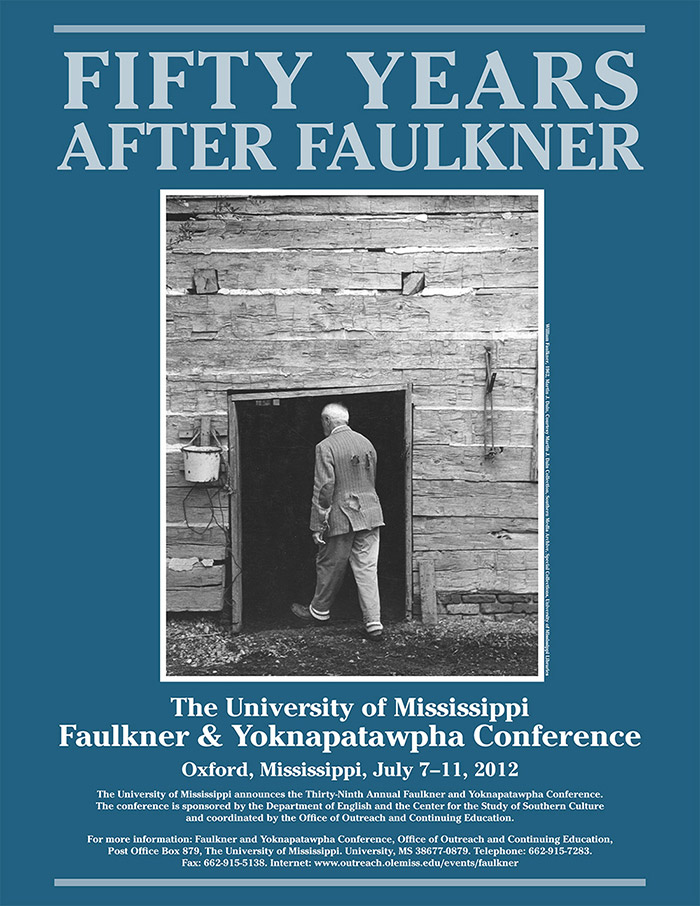
Panel. Faulkner and the Civil Rights Movement: A Reassessment
Location
Nutt Auditorium
Start Date
10-7-2012 3:30 PM
Description
- Long Faulkner: Charting Legacy on a Civil Rights Continuum / Ted Atkinson, Mississippi State University
The concept of a “civil rights continuum” functions as a critical framework for reflecting on Faulkner’s legacy in a time frame extending from post-World War II labor activism through the post-Civil Rights era. Responsive to the call for a “long Civil Rights Movement” to trouble conventional periodization, this continuum affords a revealing long view of Faulkner’s civil rights legacy, as illustrated by two key coordinates charted in the discussion: the spatial rendering of proliferating boundaries in Intruder in the Dust in relation to the enduring trope of Mississippi as “the closed society” and the temporal rendering of the past as “not even past” in Requiem for a Nun as strategically deployed in the discourse of post-racialism. - Faulkner and the Inheritors of Slavery / David A. Davis, Mercer University
William Faulkner’s short story “Pantaloon in Black” (1940) and Richard Wright’s documentary narrative Twelve Million Black Voices (1941) depict the misunderstanding between black and white southerners in the generation before the civil rights movement. Faulkner focuses on the white community’s confusion about Rider’s grief over his wife’s death, which has disastrous results. Wright attempts to explain the history and experience of blacks to whites, adopting a didactic, first-person plural narrative voice. Wright’s narrative approach helps to explain the abrupt shift from third-person narration to the white deputy sheriff’s voice in Faulkner’s story, which signals the mysterious separation between the races in the South. - Who was William Faulkner to them?: Civil Rights Workers, Mississippi Moderates and Faulkner / Sharon Monteith, University of Nottingham
In an essay titled “Faulkner and the Racial Crisis” Louis Daniel Brodsky asserts that both groups in my title were Faulkner’s detractors as a result of his “gradualist” position on civil rights. This paper explores that claim by examining civil rights organizers and Mississippi’s Freedom Summer volunteers, black and white, who were inspired by his work, and crusading racial liberals with whom Faulkner aligned himself to write satirically about segregation. Literary scholar Louis Rubin once imagined the ghost of Faulkner on the University of Mississippi campus in 1962. He mused “I think perhaps he would have put on his coat and tie and hat and gone over to the campus and stood quietly alongside of James Meredith. Would it have made any difference? I doubt it. Most of the citizens who milled about the campus would not have known who he was, or if they had, they would not have cared. Who was William Faulkner to them?” This paper teases out some possible answers to that question.
Relational Format
Conference proceeding
Recommended Citation
Atkinson, Ted; Davis, David A.; and Monteith, Sharon, "Panel. Faulkner and the Civil Rights Movement: A Reassessment" (2012). Faulkner and Yoknapatawpha Conference. 42.
https://egrove.olemiss.edu/fy/2012/schedule/42
COinS
Jul 10th, 3:30 PM
Panel. Faulkner and the Civil Rights Movement: A Reassessment
Nutt Auditorium
- Long Faulkner: Charting Legacy on a Civil Rights Continuum / Ted Atkinson, Mississippi State University
The concept of a “civil rights continuum” functions as a critical framework for reflecting on Faulkner’s legacy in a time frame extending from post-World War II labor activism through the post-Civil Rights era. Responsive to the call for a “long Civil Rights Movement” to trouble conventional periodization, this continuum affords a revealing long view of Faulkner’s civil rights legacy, as illustrated by two key coordinates charted in the discussion: the spatial rendering of proliferating boundaries in Intruder in the Dust in relation to the enduring trope of Mississippi as “the closed society” and the temporal rendering of the past as “not even past” in Requiem for a Nun as strategically deployed in the discourse of post-racialism. - Faulkner and the Inheritors of Slavery / David A. Davis, Mercer University
William Faulkner’s short story “Pantaloon in Black” (1940) and Richard Wright’s documentary narrative Twelve Million Black Voices (1941) depict the misunderstanding between black and white southerners in the generation before the civil rights movement. Faulkner focuses on the white community’s confusion about Rider’s grief over his wife’s death, which has disastrous results. Wright attempts to explain the history and experience of blacks to whites, adopting a didactic, first-person plural narrative voice. Wright’s narrative approach helps to explain the abrupt shift from third-person narration to the white deputy sheriff’s voice in Faulkner’s story, which signals the mysterious separation between the races in the South. - Who was William Faulkner to them?: Civil Rights Workers, Mississippi Moderates and Faulkner / Sharon Monteith, University of Nottingham
In an essay titled “Faulkner and the Racial Crisis” Louis Daniel Brodsky asserts that both groups in my title were Faulkner’s detractors as a result of his “gradualist” position on civil rights. This paper explores that claim by examining civil rights organizers and Mississippi’s Freedom Summer volunteers, black and white, who were inspired by his work, and crusading racial liberals with whom Faulkner aligned himself to write satirically about segregation. Literary scholar Louis Rubin once imagined the ghost of Faulkner on the University of Mississippi campus in 1962. He mused “I think perhaps he would have put on his coat and tie and hat and gone over to the campus and stood quietly alongside of James Meredith. Would it have made any difference? I doubt it. Most of the citizens who milled about the campus would not have known who he was, or if they had, they would not have cared. Who was William Faulkner to them?” This paper teases out some possible answers to that question.

